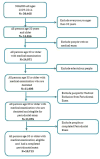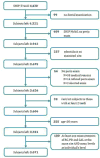Age-dependent distribution of periodontitis in two countries: Findings from NHANES 2009 to 2014 and SHIP-TREND 2008 to 2012
- PMID: 29926940
- PMCID: PMC6028062
- DOI: 10.1002/JPER.17-0670
Age-dependent distribution of periodontitis in two countries: Findings from NHANES 2009 to 2014 and SHIP-TREND 2008 to 2012
Abstract
Objective: We used epidemiologic data of clinical periodontal status from two population-based samples in two countries, United States and Germany, to examine 1) the impact of age on the relative contribution of recession and pocketing on the distribution of clinical attachment loss, and 2) whether it is feasible to define age-dependent thresholds for severe periodontitis.
Methods: The analytical sample was based on persons aged ≥30 and included 10,713 individuals in the United States, participants in NHANES 2009 to 2014, and 3,071 individuals in Pomerania, Germany, participants in the SHIP-Trend 2008 to 2012. NHANES used a full-mouth examination protocol to collect data on recession (R), pocket depth (PD) and clinical attachment loss (CAL) for six sites/tooth on a maximum of 28 teeth; SHIP-Trend used a half-mouth examination at four sites/tooth. In both samples, percentile distributions of mean CAL/person were generated for each 5-year age interval. Age-dependent thresholds defining the upper quintile of mean CAL were calculated for both samples. The topographic intraoral distribution of CAL and the relative contribution of R and PD on CAL was assessed.
Results: Mean CAL increased linearly with age in both samples and was higher in SHIP-Trend than NHANES across the age spectrum. In contrast, mean PD was constant across age groups in both populations. R contributed increasingly to CAL with age, especially after 45 to 49 years. Upper quintile mean CAL thresholds in NHANES were < 3 mm for ages up to 39 years, and under 3.58 mm in all other age groups. Corresponding values in SHIP-Trend were also < 3 mm in ages up to 39 years but increased linearly with age up to 7.21 mm for ages ≥75 years.
Conclusions: Despite substantial differences in the overall severity of attachment loss between the two samples, common patterns of CAL and of the relative contribution of R and PD to CAL with increasing age were identified. Although periodontitis severity may vary in different populations, empirical evidence-driven definitions of CAL thresholds signifying disproportionate severity of periodontitis by age are feasible.
Keywords: classification; clinical attachment loss; epidemiology; periodontitis; pocket depth; recession.
© 2018 American Academy of Periodontology and European Federation of Periodontology.
Conflict of interest statement
The authors do not have any financial or other competing interests to declare.
Figures


















































References
-
- Centers for Disease Control and Prevention. National Health and Nutrition Examination Survey. Questionnaires, Datasets, and Related Documentation. Available at: http://www.cdc.gov/nchs/nhanes/nhanes_questionnaires.htm. Accessed September 29, 2017.
-
- World Health Organization Health Impact Assessment. The Determinants of Health. Available at http://www.who.int/hia/evidence/doh/en/. Accessed October 2017.
-
- Burt BA. Definitions of risk. J Dent Educ. 2001;65:1007–1008. - PubMed
Publication types
MeSH terms
Grants and funding
LinkOut - more resources
Full Text Sources
Other Literature Sources

